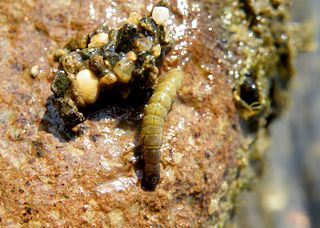Related Research Articles
Freshwater ecosystems are a subset of Earth's aquatic ecosystems. They include lakes, ponds, rivers, streams, springs, bogs, and wetlands. They can be contrasted with marine ecosystems, which have a larger salt content. Freshwater habitats can be classified by different factors, including temperature, light penetration, nutrients, and vegetation. There are three basic types of freshwater ecosystems: Lentic, lotic and wetlands. Freshwater ecosystems contain 41% of the world's known fish species.

The benthic zone is the ecological region at the lowest level of a body of water such as an ocean, lake, or stream, including the sediment surface and some sub-surface layers. The name comes from ancient Greek, βένθος (bénthos), meaning "the depths." Organisms living in this zone are called benthos and include microorganisms as well as larger invertebrates, such as crustaceans and polychaetes. Organisms here generally live in close relationship with the substrate and many are permanently attached to the bottom. The benthic boundary layer, which includes the bottom layer of water and the uppermost layer of sediment directly influenced by the overlying water, is an integral part of the benthic zone, as it greatly influences the biological activity that takes place there. Examples of contact soil layers include sand bottoms, rocky outcrops, coral, and bay mud.

Tailwater refers to waters located immediately downstream from a hydraulic structure, such as a dam, spillway, bridge or culvert. Generally measured and reported as the average water depth downstream of a hydraulic structure, tailwater can vary based on the outlet from the structure as well as downstream influences that may restrict or advance the usual flow of water from the structure. The creation of a tailwater will have significant impacts on both the abiotic and biotic conditions of the waterway.

A bioindicator is any species or group of species whose function, population, or status can reveal the qualitative status of the environment. The most common indicator species are animals. For example, copepods and other small water crustaceans that are present in many water bodies can be monitored for changes that may indicate a problem within their ecosystem. Bioindicators can tell us about the cumulative effects of different pollutants in the ecosystem and about how long a problem may have been present, which physical and chemical testing cannot.
RIVPACS is an aquatic biomonitoring system for assessing water quality in freshwater rivers in the United Kingdom. It is based on the macroinvertebrate species found at the study site during sampling. Some of these species are tolerant to pollution, low dissolved oxygen, and other stressors, but others are sensitive; organisms vary in their tolerances. Therefore, different species will usually be found, in different proportions, at different river sites of varying quality. Some organisms are especially good indicator species. The species found at the reference sites collectively make up the species assemblage for that site and are the basis for a statistical comparison between reference sites and non-reference sites. The comparison between the expected species and the observed species can then be used to estimate this aspect of the ecological health of a river.

An aquatic ecosystem is an ecosystem found in and around a body of water, in contrast to land-based terrestrial ecosystems. Aquatic ecosystems contain communities of organisms—aquatic life—that are dependent on each other and on their environment. The two main types of aquatic ecosystems are marine ecosystems and freshwater ecosystems. Freshwater ecosystems may be lentic ; lotic ; and wetlands.

Aquatic biomonitoring is the science of inferring the ecological condition of rivers, lakes, streams, and wetlands by examining the organisms that live there. While aquatic biomonitoring is the most common form of biomonitoring, any ecosystem can be studied in this manner.

The New Zealand mud snail is a species of very small freshwater snail with a gill and an operculum. This aquatic gastropod mollusk is in the family Tateidae.

Austropotamobius pallipes is an endangered European freshwater crayfish, and the only crayfish native to the British Isles. Its common names include white-clawed crayfish and Atlantic stream crayfish.

River ecosystems are flowing waters that drain the landscape, and include the biotic (living) interactions amongst plants, animals and micro-organisms, as well as abiotic (nonliving) physical and chemical interactions of its many parts. River ecosystems are part of larger watershed networks or catchments, where smaller headwater streams drain into mid-size streams, which progressively drain into larger river networks. The major zones in river ecosystems are determined by the river bed's gradient or by the velocity of the current. Faster moving turbulent water typically contains greater concentrations of dissolved oxygen, which supports greater biodiversity than the slow-moving water of pools. These distinctions form the basis for the division of rivers into upland and lowland rivers.

Freshwater swamp forests, or flooded forests, are forests which are inundated with freshwater, either permanently or seasonally. They normally occur along the lower reaches of rivers and around freshwater lakes. Freshwater swamp forests are found in a range of climate zones, from boreal through temperate and subtropical to tropical.

The rusty crayfish is a large, aggressive species of freshwater crayfish which is native to the United States, in the Ohio River Basin in parts of Ohio, Kentucky, and Indiana. Its range is rapidly expanding across much of eastern North America, displacing native crayfishes in the process. The rusty crayfish was first captured in Illinois in 1973, and has been collected at over 20 locations in the northern portion of the state. In 2005, F. rusticus was found for the first time west of the Continental Divide, in the John Day River, Oregon, which runs into the Columbia River.

A riffle is a shallow landform in a flowing channel. Colloquially, it is a shallow place in a river where water flows quickly past rocks. However, in geology a riffle has specific characteristics.

Stephanie Peay is a British ecologist and crayfish researcher.

Energy, nutrients, and contaminants derived from aquatic ecosystems and transferred to terrestrial ecosystems are termed aquatic-terrestrial subsidies or, more simply, aquatic subsidies. Common examples of aquatic subsidies include organisms that move across habitat boundaries and deposit their nutrients as they decompose in terrestrial habitats or are consumed by terrestrial predators, such as spiders, lizards, birds, and bats. Aquatic insects that develop within streams and lakes before emerging as winged adults and moving to terrestrial habitats contribute to aquatic subsidies. Fish removed from aquatic ecosystems by terrestrial predators are another important example. Conversely, the flow of energy and nutrients from terrestrial ecosystems to aquatic ecosystems are considered terrestrial subsidies; both aquatic subsidies and terrestrial subsidies are types of cross-boundary subsidies. Energy and nutrients are derived from outside the ecosystem where they are ultimately consumed.

Macroinvertebrate Community Index (MCI) is an index used in New Zealand to measure the water quality of fresh water streams. The presence or lack of macroinvertebrates such as insects, worms and snails in a river or stream can give a biological indicator on the health of that waterway. The MCI assigns a number to each species of macroinvertebrate based on the sensitivity of that species to pollution. The index then calculates an average score. A higher score on the MCI generally indicates a more healthy stream.

DNA barcoding is an alternative method to the traditional morphological taxonomic classification, and has frequently been used to identify species of aquatic macroinvertebrates. Many are crucial indicator organisms in the bioassessment of freshwater and marine ecosystems.

Aquatic macroinvertebrates are insects in their nymph and larval stages, snails, worms, crayfish, and clams that spend at least part of their lives in water. These insects play a large role in freshwater ecosystems by recycling nutrients as well as providing food to higher trophic levels.

The Aquatic Macroinvertebrate Collection is a Queensland Government scientific collection based in Queensland, Australia. The collection consists of aquatic macroinvertebrate specimens from rivers, streams, springs, wetlands, and other freshwater sources in Queensland.
Luiz Alonso Ramírez Ulate is a Costa Rican ecologist and a professor at North Carolina State University. From 2020 to 2021 he served as president of the Society for Freshwater Science.
References
- 1 2 Porter, Phil; Faulkner, Annette (2022). "Richard Chadd: An Appreciation". The Lincolnshire Naturalist. 30 (3): 122.
- ↑ "Press release: New stronghold for endangered crayfish in Lincolnshire". Environment Agency. 9 September 2019. Retrieved 23 November 2022.
- ↑ "Foreword" (PDF). FBA News. No. 81. Winter 2021. p. 3.
- ↑ "Richard Chadd" (PDF). The Riverfly Partnership Newsletter. November 2021.